Lab Diaries #7 - Creating Your Own Super Cool ̶K̶i̶l̶l̶e̶r̶ ̶M̶u̶t̶a̶n̶t̶ Safe to Use Virus From Scratch - Part I
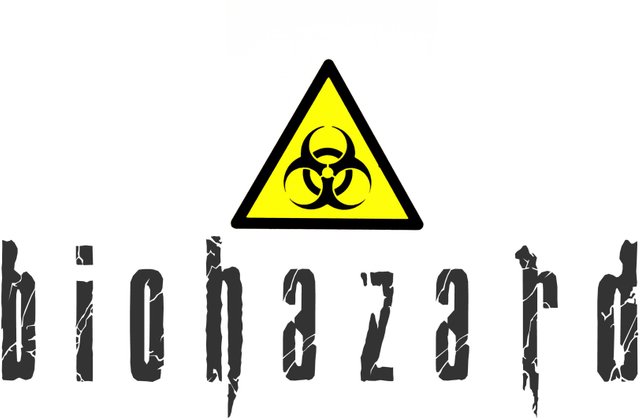
The pleasant sign I see every day at work, authors George Hodan and Capcom, CC0 1.0
- Wait, are you trying to tell me that you can insert ANY gene you can think of and create a virus carrying that gene, which is capable of infecting human cells, in your lab? Is that safe?
- Of course it's perfectly safe, nothing to worry about. As long as you follow ALL 297 safety procedures. And you must perform ALL 53 steps of the protocol correctly. And you must be well trained and fully focused ALL the time. Did I leave my stove on?
In one of my previous Lab Diaries posts I wrote about creating a transgenic cell line that expresses our gene of interest, also called knock-in (KI) cell line. We did this by using commercially available lentivirus particles that were already carrying the vector with our gene of interest. This is easier and of course more expensive way to go, but as every other approach, it has its advantages and drawbacks, which will not be discussed here in detail.
One important drawback of buying pre-made lentiviruses must be taken into consideration though - they have an expiration date of one year from the day of purchase, meaning that, after one year in -80°C they are no longer capable of infecting sufficient number of target cells, and you can throw them away (which happened to me actually, so we had to buy a new virus - not cheap!).
The other, much more complicated fun approach, is to actually make virus particles with the gene of interest in your lab! Before we dive into the explanation of this procedure, which is full of fancy words you never heard of, let's make a proper introduction to the topic by defining some of them.
Gene knock-in, knockout and knockdown
Gene knock-in
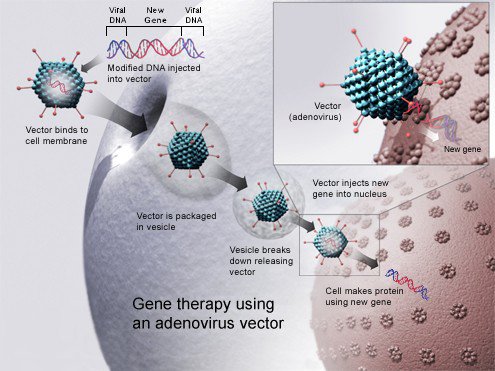
Gene knock-in applied in gene therapy, author NIH, CC0 1.0
I already mentioned that I performed a gene knock-in in one of the multiple myeloma cell lines. During the gene knock-in procedure, a gene of interest is inserted into the host genome, and as such, expressed as a protein product. Except in research, gene knock-in is used as an approach in gene therapy as well, where "healthy" copy of the gene is delivered into the patient's cells in order to either replace a faulty gene or to introduce a complete new gene.
Gene knockout
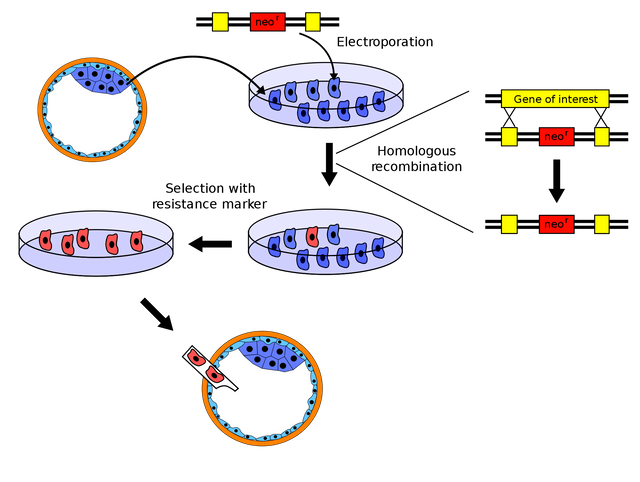
Creating a knockout mouse, author Kjaergaard, CC BY 3.0
Gene knockout represents a technique opposite of gene knock-in, during which a permanent change in the host DNA is made, such that an inactivation of the target gene is performed, with the goal of investigating consequences of the loss of function of gene of interest. This approach is commonly used to create knockout organisms (such as mice), which are then used to study the function of a particular gene.
Gene knockdown (gene silencing)
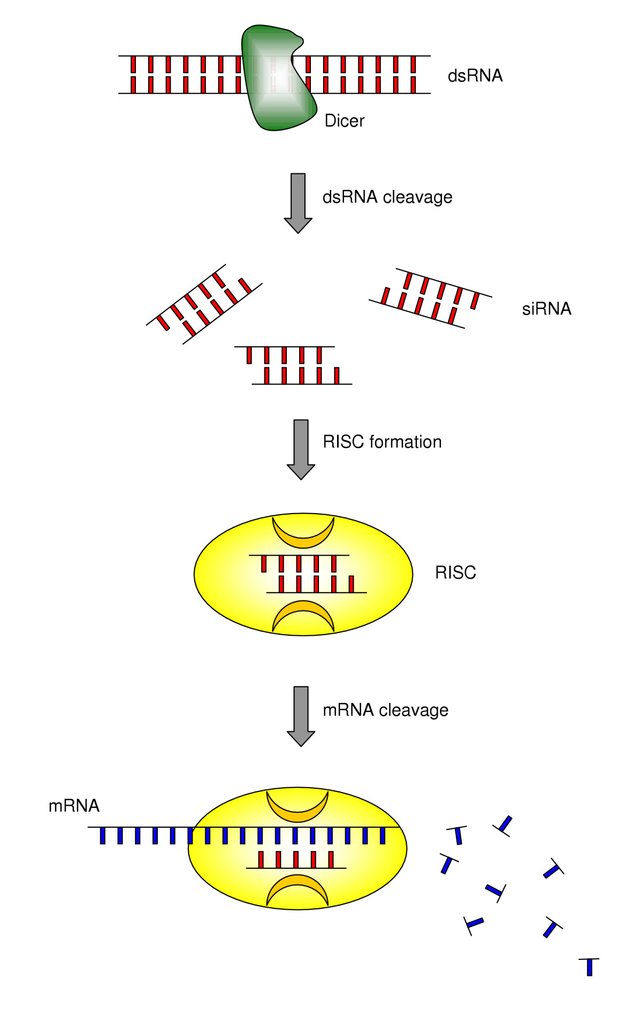
RNA interference (RNAi), author Simone Mocellin and Maurizio Provenzano, CC BY 2.0
- Wait, now I'm confused - there're gene knockout and gene knockdown? I thought these two are the same thing!
Actually, no, there's a huge difference between those two techniques. While in gene knockout changes in the host genome are made, gene knockdown results in a temporary decrease of target gene expression without producing any changes in the chromosomal DNA. This is achieved in several ways, out of which two approaches are mostly used - binding of the precisely designed oligonucleotide to the gene itself and preventing it from being transcribed and through degradation of mRNA (RNAi).
A short hairpin RNA or shRNA is an artificially designed RNA molecule with the secondary structure of a hairpin. shRNAs are used for gene silencing which is performed through the mechanism of RNAi, and we will see about this process in more detail, since I'll be performing gene silencing using lentiviral vectors which carry the sequence of the shRNA that are supposed to decrease the expression of my gene of interest.
Plasmids and vectors
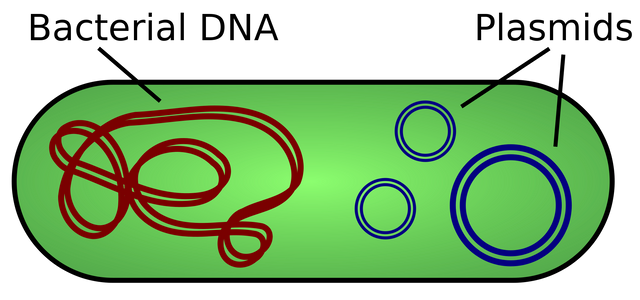.svg.png)
Plasmids, author Spaully, CC BY-SA 2.5
The term "plasmid" was coined in 1952 to describe any heritable element that is distinct from a cell’s chromosomal DNA. Today we know that plasmids are usually circular, double-stranded DNA (dsDNA) molecules, found mostly in bacteria, yeast and in some of the more complex eukaryotic cells, and that they carry some genes essential for their host (like ones that confer antibiotic resistance) and can replicate independently from chromosomal DNA.
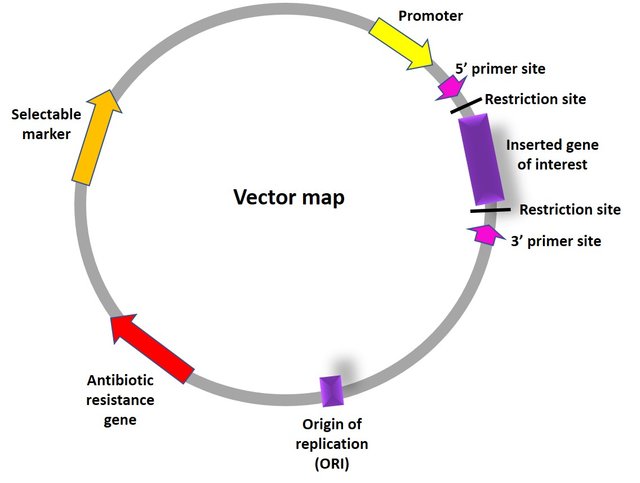
Vector map, author @scienceangel
Vectors are basically artificially manipulated plasmids used as tools in molecular biology, in the field of recombinant DNA technology called molecular cloning. During this procedure, a foreign DNA fragment (eg. gene which we want to express in target cells) is inserted into the plasmid backbone, generating in that way a recombinant DNA molecule or in this case, a cloning vector. I made a scheme of the vector similar to one I will use in my experiments, where you can see some of the most important elements one vector needs to contain to be used successfully in the research:
Origin of replication (ORI) - a sequence required for replication/amplification of the plasmid, represents a place where bacterial replication machinery is recruited and where replication starts.
Antibiotic resistance gene - this gene provides a selective advantage to the host by conferring resistance to the specific antibiotic (eg. ampicillin). This gene allows a researcher to perform selection of only those bacteria that are carrying the plasmid with the gene of interest, by adding the antibiotic into the growing media, and killing those bacteria that don't have the plasmid, and are not resistant to ampicillin as well.
Selectable marker - Is used to select the host cells (eg. human cells) that have successfully taken up the plasmid, and is usually another antibiotic resistance gene (but transcribed from the host promoter, not bacterial one) or it can be a gene coding for a fluorescent protein that allows visualization of transfected cells under the fluorescent microscope or in the flow cytometry. Here is important to notice that selectable marker is different than the antibiotic resistance gene, which is used to make a selection in the bacterial culture (this difference will become clear when we jump to the procedure).
Gene insert - Our gene of interest that we want to study.
Promoter - A promoter region is crucial element within the plasmid, because it recruits transcriptional machinery from the host cell and directs transcription/expression of our gene of interest. Promoter strength is a major parameter to watch out for when choosing the promoter for your plasmid.
Restriction sites - short sequences contained within the plasmid that represent recognition spots for restriction enzymes, that allow insertion of our gene of interest by digestion and ligation performed by the restriction enzyme.
Gene silencing by lentiviral delivery of shRNA
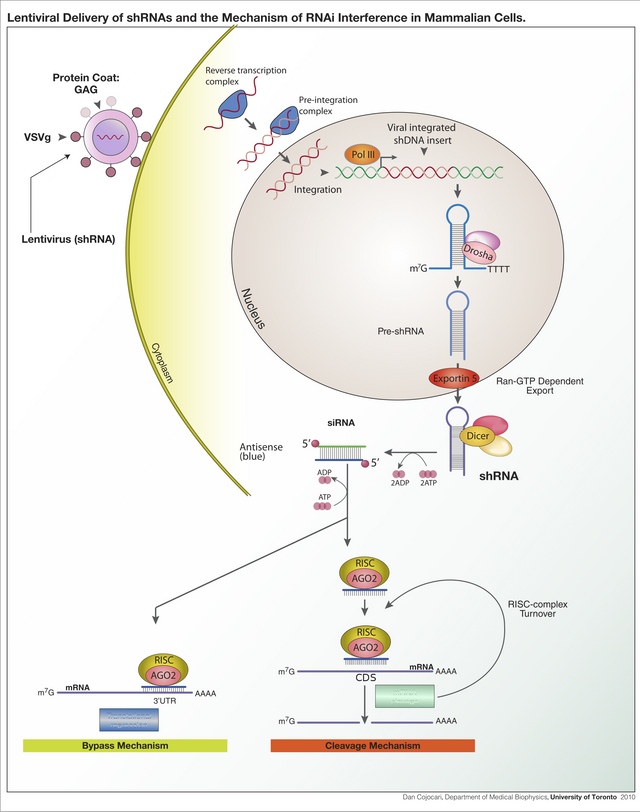
Lentiviral delivery of shRNA, author Dan Cojocari, CC BY-SA 3.0
Now that we learned what is gene silencing and what are plasmids/vectors, we can quickly go through molecular mechanism of RNAi gene silencing by using lentiviral particles for the delivery of shRNA that is supposed to target, or silence the expression of our gene of interest. This is something I will be doing in the following months.
Lets imagine that after weeks of hard work, we finally managed to make our own lentiviral particles, in such way that they carry the vector we selected, and within that vector lies gene insert that codes for the shRNA that has a sequence which is complementary to the mRNA of the gene we want to silence/decrease its expression. To make our cancer (host, target) cells transcribe/express the shRNA sequence, it needs to be incorporated into the host cell genome first. This is where our lentivirus takes all the glory, and incorporates plasmid we inserted inside of its envelope (including our shRNA sequence) into the transcriptionally active chromatin regions of host cell genome.
Once the shRNA sequence is integrated into the cancer cells, it is transcribed by the RNA Polymerase II or III, and now such RNA product is performing a molecular mimicry, which means that it imitates naturally occurring pri-microRNA (pri-miRNA) in cells. Such RNAs are processed by ribonuclease protein Drosha, which cleaves single-stranded parts of pri-shRNA, yielding so-called pre-shRNA, which then gets out of the nucleus with the help of protein called Exportin 5.
Once this pre-shRNA/Exportin 5 complex gets to cytoplasm, it is further processed by the Dicer protein, which cleaves long double-stranded RNA (dsRNA), leaving short dsRNA. At the end, dsRNA is transformed into two single-stranded RNAs (ssRNAs), with one of them being the passenger, and the other one the guide strand. The guide (antisense) strand is then loaded into the RNA-induced silencing complex (RISC), and this strand performs the function of guiding the RISC to the complementary (target gene) mRNA which is then destroyed by the RISC.
Yup, and we expect all of this to happen to have a successful experiment... The beauty of science!
In the next post I will describe in detail preparation process of lentiviral particles, step by step.
Needless to say, but - don't try that at home!
Until then, keep steemSTEM! ;)
Literature
RNA interference: learning gene knock-down from cell physiology
Short Hairpin RNA (shRNA): Design, Delivery, and Assessment of Gene Knockdown

Nice work. Gene silencing is difficult to explain and you’ve done a fantastic job.
Thank you so much, really appreciate it! :)
This post has been voted on by the steemstem curation team and voting trail.
There is more to SteemSTEM than just writing posts, check here for some more tips on being a community member. You can also join our discord here to get to know the rest of the community!
Hi @scienceangel!
Your post was upvoted by utopian.io in cooperation with steemstem - supporting knowledge, innovation and technological advancement on the Steem Blockchain.
Contribute to Open Source with utopian.io
Learn how to contribute on our website and join the new open source economy.
Want to chat? Join the Utopian Community on Discord https://discord.gg/h52nFrV
This is as interesting as it can be. Waiting in anticipation for the subsequent post. This really got me fascinated.
Thank you very much @cyprianj!
Great post. We learn and do what nature has been doing for millions of years.
Why i am not well in biology, i read it but only a little get in my mind. But it is looking great and well written.
Thanks for sharing...
Thank you very much, and thanks for dropping by!
If you buy them is Serbia, always, ALWAYS, check if the label is re-glued :D
True that :D
I must incorporate some of these procedures into my cooking routine. The kitchen is definitely a biohazard when I'm done with it...
Congratulations @scienceangel! You have completed the following achievement on the Steem blockchain and have been rewarded with new badge(s) :
Click on the badge to view your Board of Honor.
If you no longer want to receive notifications, reply to this comment with the word
STOPCongratulations @scienceangel! You have completed the following achievement on the Steem blockchain and have been rewarded with new badge(s) :
Click on the badge to view your Board of Honor.
If you no longer want to receive notifications, reply to this comment with the word
STOPDo not miss the last post from @steemitboard: